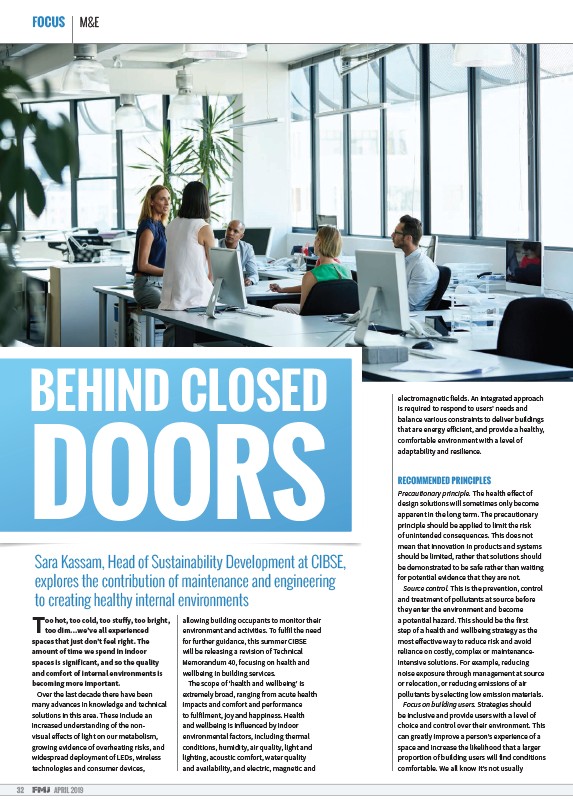
FOCUS M&E
Sara Kassam, Head of Sustainability Development at CIBSE,
explores the contribution of maintenance and engineering
to creating healthy internal environments
Too hot, too cold, too stu y, too bright,
too dim…we’ve all experienced
spaces that just don’t feel right. The
amount of time we spend in indoor
spaces is significant, and so the quality
and comfort of internal environments is
becoming more important.
Over the last decade there have been
many advances in knowledge and technical
solutions in this area. These include an
increased understanding of the nonvisual
e ects of light on our metabolism,
growing evidence of overheating risks, and
widespread deployment of LEDs, wireless
technologies and consumer devices,
32 APRIL 2019
allowing building occupants to monitor their
environment and activities. To fulfil the need
for further guidance, this summer CIBSE
will be releasing a revision of Technical
Memorandum 40, focusing on health and
wellbeing in building services.
The scope of ‘health and wellbeing’ is
extremely broad, ranging from acute health
impacts and comfort and performance
to fulfilment, joy and happiness. Health
and wellbeing is influenced by indoor
environmental factors, including thermal
conditions, humidity, air quality, light and
lighting, acoustic comfort, water quality
and availability, and electric, magnetic and
electromagnetic fields. An integrated approach
is required to respond to users’ needs and
balance various constraints to deliver buildings
that are energy e icient, and provide a healthy,
comfortable environment with a level of
adaptability and resilience.
RECOMMENDED PRINCIPLES
Precautionary principle. The health e ect of
design solutions will sometimes only become
apparent in the long term. The precautionary
principle should be applied to limit the risk
of unintended consequences. This does not
mean that innovation in products and systems
should be limited, rather that solutions should
be demonstrated to be safe rather than waiting
for potential evidence that they are not.
Source control. This is the prevention, control
and treatment of pollutants at source before
they enter the environment and become
a potential hazard. This should be the first
step of a health and wellbeing strategy as the
most e ective way to reduce risk and avoid
reliance on costly, complex or maintenanceintensive
solutions. For example, reducing
noise exposure through management at source
or relocation, or reducing emissions of air
pollutants by selecting low emission materials.
Focus on building users. Strategies should
be inclusive and provide users with a level of
choice and control over their environment. This
can greatly improve a person’s experience of a
space and increase the likelihood that a larger
proportion of building users will find conditions
comfortable. We all know it’s not usually
BEHIND CLOSED
DOORS